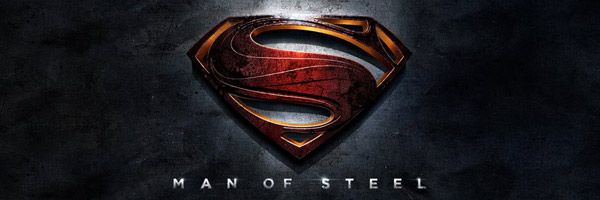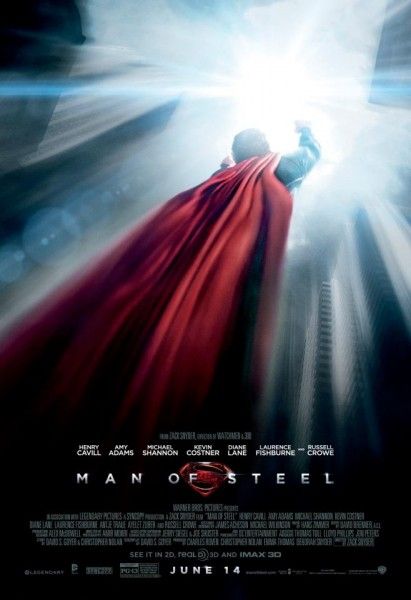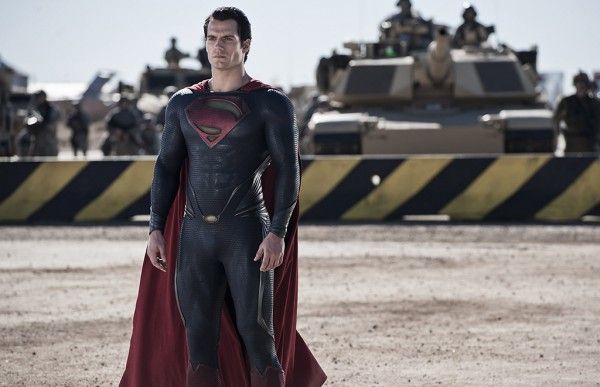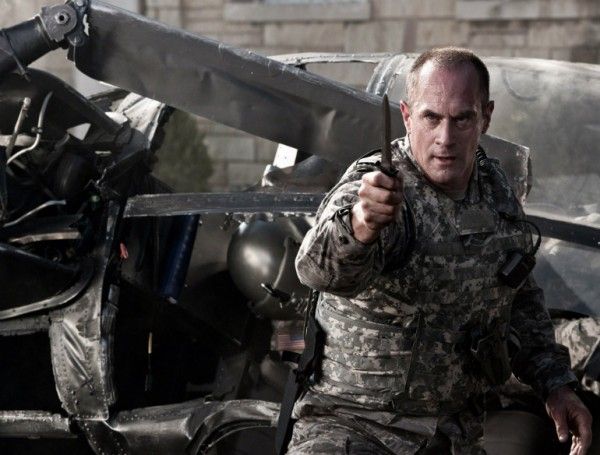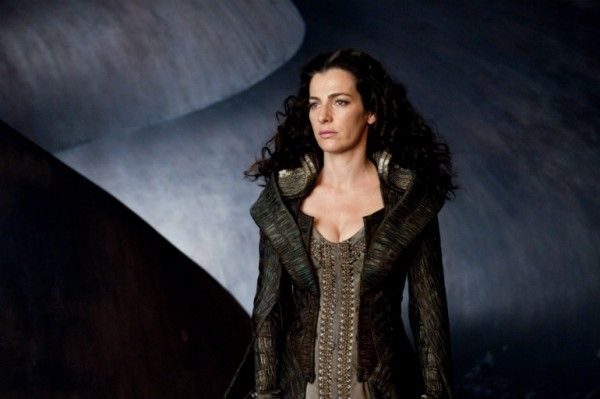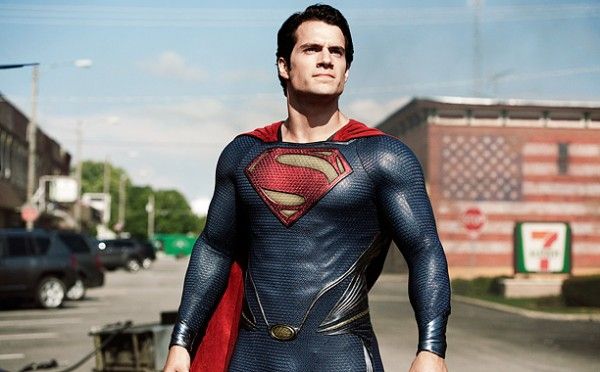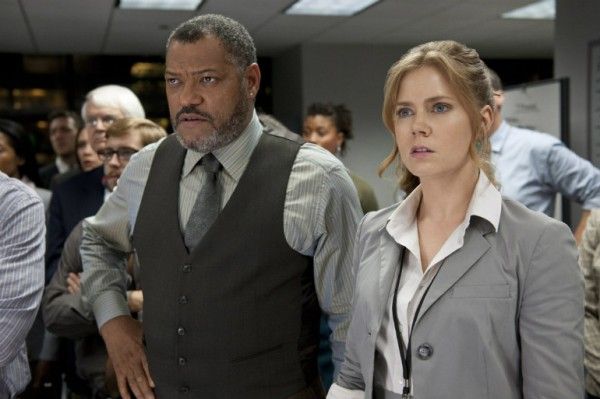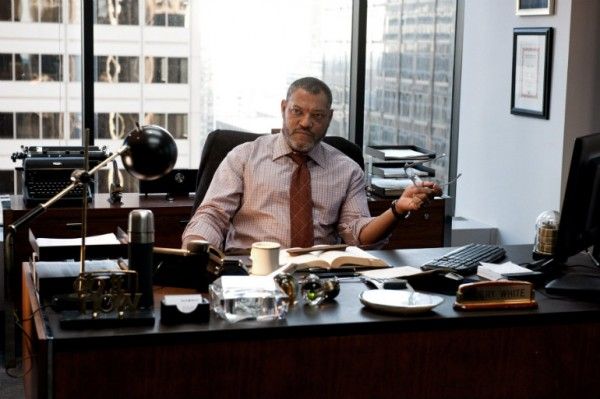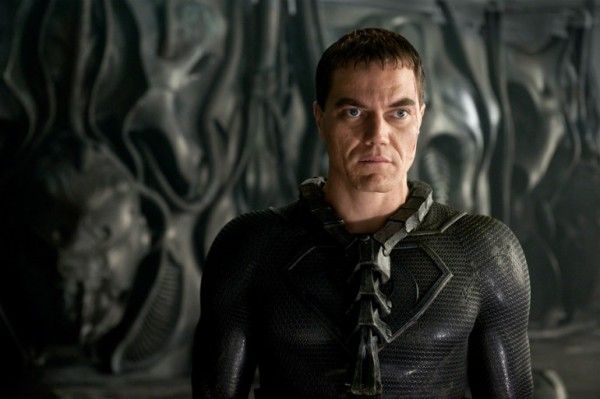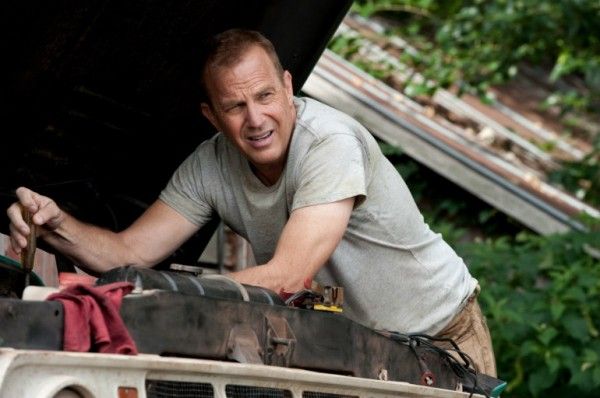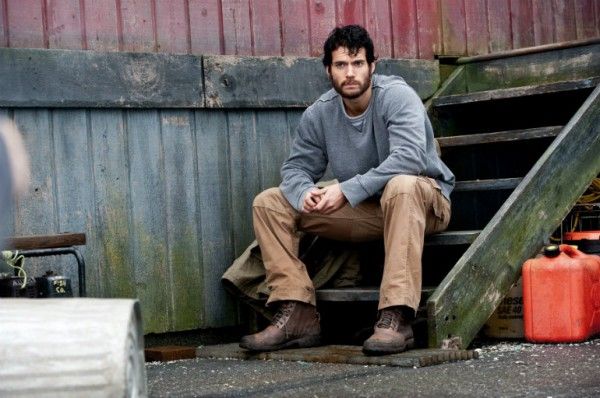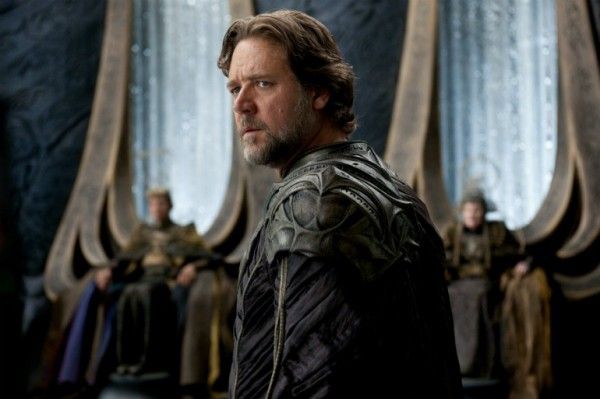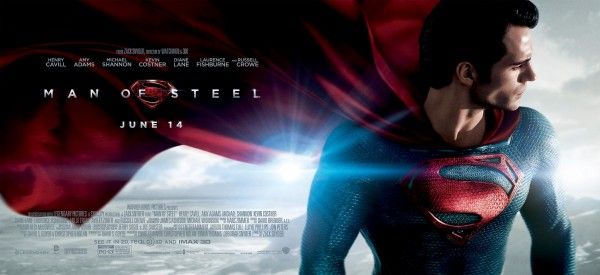Last week, Warner Bros. lifted the set visit embargo for Man of Steel. As you probably noticed, I participated in group interviews with Henry Cavill, director Zack Snyder, screenwriter David S. Goyer, producer Charles Roven, and I also posted an in-depth article about what I saw being filmed along with 60 things to know about the movie.
And I'm not done.
Shortly before sitting down with everyone individually, we were able to speak with Deborah Snyder, David S. Goyer, and Charles Roven while Zack Snyder was filming a huge action sequence on the streets of Smallville. It was an impromptu interview, and it was great to try and ask questions while also watching helicopters fly overhead. During the interview they talked about Easter Eggs, the most challenging parts of filming the movie, what they learned from the previous Superman movies, the process of writing the screenplay, whether anything was directly inspired by the comic books, and so much more. Hit the jump for what they had to say.
Question: What have you found to be, in this particular action sequence filming here, what’s been the most challenging aspect for you guys?
DEBORAH SNYDER: The news helicopters coming by and ruining our shots. [Laughs] Honestly, it’s been a little -- we’ve had some dialogue and everything and that’s been tricky. I think the coordination, really just scheduling a movie like this because you have to make sure you get all the stuff in a timely manner because then at night when they redress, you know, if you don’t get everything, right, and then they have to dress that night, you kind of get screwed because it takes a whole night for them to dress all the things. Then, there’s a couple of other things that’ll happen where they have to dress in more destruction. You have to make your dates, because that’s the time, that’s the window of opportunity where they have to dress and you can’t have the city -- you know, you have to keep progressing.
DAVID S. GOYER: Yeah, they’re trying to shoot it in order, right? If you don’t make your days, then they have to sort of dress it twice and go back to what you didn’t get.
SNYDER: Yeah, but also too, we have it scheduled where we’re shooting so we go away for one day, so you have to get everything up until that point, so it’s an enormous amount of pressure to really make all your days. You can’t say, “Oh, well we’ll come back tomorrow" because they need to be dressing in more devastation.
We noticed a little Easter egg in the town. Ezra’s Mail Depot, Ezra’s Smallville. So the question, of course, is are there other Easter eggs here in the town that we should be keeping an eye out on?
SNYDER: I think there is. I think like, Alex [McDowell] is really great at incorporating these things. A lot of times we’ve called David and say, “Okay, we need a certain name of something.” Rather than just naming it something fictitious, we always go to David because he was the most expert on all matters. He’d come up with some ideas that were really historical.
GOYER: Alex and I, McDowell, yeah, we frequently email back and forth with set dressing on just any little thing. Like, instead of making it generic, like, an elementary school that’s Weisinger Elementary School [after Superman editor Mort Weisinger], we named certain things after sort of artists or writers or things like that or characters.
So I’ll just throw it out there, you’re obviously a huge comic book fan. What’s it like to be on the set of Man of Steel and be so involved in it?
GOYER: Surreal. I mean, it’s crazy, weird.
So we’ve been joking about Superman Returns a bit. What are the lessons you guys learned from those previous films and even the Donner films?
SNYDER: You know, I think the biggest lesson for us, we took our kids to see the premiere, right? They were 10, 11 at the time. They didn’t understand it because that movie assumed that everyone -- and I think especially for kids, you know, unless you’re a die-hard fan it’s been so long since there was a Superman film that they were very confused. I feel like we made sure that when we were doing this, that we are totally reeducating you. I think you’ll enjoy it because it has the history of Superman, if you know that, but you don’t have to know that. If you’re a young kid, you can experience it for the first time and you don’t have to have any knowledge going into it.
[Pre-visualization of the action sequence is playing at this time.]
GOYER: They're watching the pre-vis.
That looks awesome. That just looks fucking awesome.
SNYDER: Well, you know Zack always, all the fights that he and Damon choreographed, we shoot them prior. Like, we’ve done a lot of the motion capture work for like, the flying stuff in LA before we even got here. They videotape it, and then they can adjust it on set, but it’s all pre-planned.
That’s already more action than the entire two and a half hours of Superman Returns. What’s interesting is on Jack the Giant Slayer, they pre-vis the whole movie, Bryan did because his second unit guy was shooting a lot of stuff and they were just matching it to his pre-vis, you know?
SNYDER: Yeah, but you know Zack would not give up... There’s no second unit on the film. There’s an aerial unit, and then we have an effects unit, but there’s no second unit because there’s not anything he wanted to give up.
So you’re not retelling the origin story or is the origin story embedded in here?
GOYER: Sort of the latter.
Sort of the latter?
GOYER: Yeah, I mean, but I think that the… I know that all diehard comic book fan chatter is like, “Oh, everybody knows all of this stuff.” But the Donner films, which we all love, have been, by the time this movie comes out, 36, 37 years. It’s something like 85 percent of the audience doesn’t know that. The vast majority of our audience weren’t even alive. Everyone assumes that. Frankly, putting aside everything else in Superman Returns, that was the single biggest problem with it is that that movie assumed that everybody knew the story and could just pick it up, and they didn’t. The vast majority of the audience, the non-geeks were alienated.
By the same token, going with Zod, and again, going back to the villain we have seen before in the earlier movies, was it because of the fact that it’s 30 years on? Some of the other people always talk about people always ask about Brainiac and stuff like that.
GOYER: The way [Christopher] Nolan and I have always approached the Batman movies as well is you never say, “Hey, which villain would be cool for this movie?” You start with the story first. What kind of story? What kind of theme do you want to tell? So we worked that out. Then, usually the villain becomes obvious in terms of who’s going to be the appropriate antagonist for that. When you guys see the movie, the only villain we could’ve used was Zod and the Kryptonians. I mean, when you see what the whole story is, nothing else would have even made sense, just like in the same way that nothing else would’ve made sense other than Bane in the other one. I mean, you let the story dictate who the right antagonist is rather than the other way around.
Was there anything that you maybe wanted to do that you were not allowed to because Warner Bros. might be trying to put together a Justice League?
GOYER: No. [To Charles Roven] Right? I mean, that never even came up. That never came up, no, it never came up.
I’m curious how long you spent writing this script, or working on this project compared to the others you’ve worked on. Did you spend a little extra time on every comma and period just because it’s Superman?
GOYER: I mean, it was definitely the hardest script I’ve ever written. I’ve been working on it on and off for two years, so depending. But yeah, it was the hardest one. I never thought -- I mean, I’ve said I didn’t think I would do Superman before, but it’s harder than Batman.
CHARLES ROVEN: It’s also the fact that while David and Chris wrote the story together, David’s the only screenwriter on this. So, he's had to spend more time.
GOYER: Yeah, so it’s been every little time we changed something military or every little time we changed something -- we have DOD assistants on this movie and that’s taken -- there’s been an enormous amount of coordination between me and the people at the Pentagon and the various branches of the military in terms of getting military accuracy right. So, they were out here, some of them are still here, but like, earlier this week, I was spending a lot of time coordinating with them on just… And they put me in touch with A-10, which are called Warthog pilots and Little Bird pilots and C-17 pilots and all of these things play in the movie. I’ve been coordinating with all of them to make sure that all the radio transmission stuff -- just every little detail is exactly right. So there’s been a lot of stuff. There’s been stuff coordinating with DC. There’s just been a lot of details.
ROVEN: There’s been a lot of constant contact with Zack and Chris and David also.
GOYER: I keep circling back like every two weeks or so. I’ll come back to set, I’ll go home. I’ll come back to set, I’ll go home.
[Train sounds]
How often does the train come by?
GOYER: A lot.
SNYDER: A lot.
GOYER: Yeah, contrary to that one report that Jonathan [Nolan] and Kurt [Johnstad] had been on the movie, which just wasn't true.
It’s interesting you’re working with the military because we saw in the animatic that the military had a big role in the action scene.
GOYER: Well, they’ve got a big role in the movie, really. Yeah, so and we thought that it would -- I mean, they have a big role in the movie, and we want it to be as authentic as possible. Once they read the script, they were happy to be on board. But there’s still an enormous amount of coordination.
Did you call up Michael Bay and say, “What are the secrets of working with them”?
GOYER: No.
SNYDER: By the way, you know, Zack went to school with Michael, actually, so he knows him.
GOYER: No, and I did a movie with Michael too. But, he’s got his own way of working. We have a slightly different way of working, although they like him very much.
They do.
GOYER: I think they’re going to be pretty happy with this one too.
When you think about Zack, you think about these very slow, very stylized shots and this is very kinetic and very fast-paced. I mean, are people going to see like, a new kind of Zack Snyder with this?
SNYDER: I think it’s a whole different -- again, the whole movie’s handheld. That’s something completely different. He just wanted to approach this film in a different way. I mean, so I think you are going to see something that’s new. I think you’re going to see something that’s more organic. Again, we’re shooting more on physical locations than we ever have before. It was very important to really put him in our real world, so that’s kind of -- I think all those decisions led to how he’s operating the camera. It all kind of -- when that’s your end goal, you make certain choices to get to that goal.
A lot of the handheld, is it kind of, on the ground, sort of in close, realistic?
SNYDER: Yeah.
GOYER: Yup, but the whole movie’s handheld.
When was that decision made? How early did you realize that?
GOYER: Early, quite early.
SNYDER: I think it was like, really early on.
GOYER: Like, in my second meeting with him.
ROVEN: The thing is, the storyboards were created with that in mind.
Batman Begins and Dark Knight clearly had certain parts of the story that were taken from comic books, or inspired from the comic book stories. Was there anything like that for this one?
GOYER: If there were, I wouldn’t tell you because that would be too spoilery.
I’m curious though, you mentioned it’s all handheld. Zack is definitely known for… In all of his movies he has a few slow motion kind of shots that are bad-ass.
SNYDER: I think you’re going to see a different -- he’s shooting the action in a different way on this one. I mean, it’s still going to be really awesome and a lot of the movie -- I mean, listen, there’s a certain style to it. You know, I don’t think it’s going to be as handheld as say like, a Bourne, where it’s very messy. But, it’s definitely, I think you’ll be pleased at the action and what he’s doing, but he is doing different things.
The Batman movies were more geared for older audiences. You mentioned that you were trying to make this accessible for kids. Is that one of the goals with this script, with this film?
SNYDER: I think it was just about making a great movie that anyone -- you know, I mean, I don’t think --
ROVEN: Yeah, we wanted to make the story as broad as possible.
SNYDER: It’s not going to be a PG movie. It won’t be that.
ROVEN: It’ll be a PG-13 movie.
You know something though? With Batman, and especially the last Batman, there’s some dark stuff in it. With Superman, is it going to be in that sort of realm of some pretty dark stuff? Or, is it going to be -- ?
GOYER: I have a good response for this. Everyone is like, “Oh, because Chris and I and Chuck worked on Batman Begins and Dark Knight, blah, blah, blah, those are all really dark, ergo, Superman’s going to be really dark,” which isn’t true. Our approach to those Batman movies was just to make them more real, to make them not comic book movies, to make them sit in the real world. Man of Steel is the same thing. He sits in the real world. That doesn’t necessarily mean that it’s dark. It’s just that it’s a more realistic, non-comic-booky approach. It’s not Dick Tracy. He exists in the real world.
ROVEN: And hopefully the character has some complex things going on that he has to deal with that are more real life than if we were just doing a comic book.
As you said, his world is his world. The other comic world, the other character’s world is his own world.
GOYER: Yeah, this is true to the Superman world. It’s just that, this is an attempt to depict a slightly more realistic take on it. That doesn’t mean that it’s going to be Goth Superman or something like that.
Well, was there anything that you were writing that you took out because you said, “This is too much, this is too cartoony, this is too something,” and you said, “This isn’t going to fit in my realistic way or portraying this character”?
GOYER: No, only because that was the approach from the beginning. I mean, it was always just, if this kind of really happened in the real world, even in terms of how his powers work, I mean, Zack and his team did a really interesting sort of scale of power, and they did a sort of how much fire power each of the.. .a 40 caliber bullet, a .50, you know, these kinds of things, like a shell grenade would work on a human versus a Kryptonian. Like, you’ll get the physics on all of that, so that like, an M-4 would knock a human back this far. An M-4 would knock a Kryptonian back this far. You know, the fire power from the A-10 Warthogs would knock a human back this far. It will knock a Kryptonian back this far. So, we sort of did all the physics on it, or Zack’s team did all the physics, so that it’s that attempt. So there are rules and science rules within this movie and this universe that things have to apply to, so it’s not just like, magically do whatever. The Kryptonians can jump yea high in our gravity kind of thing. They can punch this hard, lift this much, that sort of thing.
How does that inform the human relationships like with Lois and what not? The quest for reality I guess, like how?
GOYER: Well, I mean, it informs the human relationships in terms of the Kryptonians are this strong and the humans are that strong.
No, but I mean just in terms of Superman’s relationship with Lois, how—I don’t know, realistic is the word I want to use -- but, how is that different within this vision?
ROVEN: I think we've tried to create real choices that the characters have to make as a result of the world that they live in and the incidents that happen in that world that causes them to have to make those choices. We tried to make their analysis of those choices as in depth and as emotional and dramatic as we could.
So with a reality based approach, how do you deal with the fact that he puts on glasses and nobody recognizes him?
GOYER: You gotta see the movie.
Is there a role for humor, and what is that role?
GOYER: Yeah, there’s a role for humor. I think that it’s not the Richard Lester version. But there are definitely funny things in the movie.
Are there characters who specifically bring the comedy, sort of comic relief characters? Or, does everyone get some?
GOYER: Is there a Richard Pryor?
A Laurence Fishburne could certainly add humor.
GOYER: Different characters have moments of humor in the movie, even Henry has moments of humor in the movie, but there’s not a -- I don’t think there’s a comic relief character.
A lot of the modern criticisms of Superman is that he’s a boy scout and the truth, justice, and American way is too hokey for modern audiences.
SNYDER: I think Superman is also a man. Like, you see him as a guy. I think that that’s an important part of being able to relate to him, that…
Did you find any music cues when you were writing the screenplay, like Superman theme? I think that’s a big thing with a lot of us is we’re curious. Are you guys going with a whole new version of the soundtrack of the theme, or are you going to try to maybe incorporate certain aspects of the iconic music?
SNYDER: I think that’s going to be a development process. I know Zack has been talking a lot about the music and music is very important to him in his films, and as it will be in this one. Obviously, the music was important in those films, but nothing yet has really --
GOYER: And I don’t write with music cues.
Of course, the most important question, will Lois be singing in the film?
SNYDER: [Laughs]
ROVEN: I’ll let you answer that. I think you guys know me. I wouldn’t say anything.
Since you’re going for realism in the same way that Batman Begins and Dark Knight, is this a world where they could potentially interact? I’m not asking about plans, but is that something that you think would be possible in this case?
GOYER: I swear to God, I don’t know.
So no mention of Gotham at any point, or that you know of in the movie, even like, a Gotham newspaper?
GOYER: I don’t think so.
ROVEN: Really, we just really focused on this character.
SNYDER: On this world.
ROVEN: This character and this world.
SNYDER: It’s like, enough work to do. Are you kidding me? [Laughs]
I mean, I guess what I’m saying is there seems to be like at The Daily Planet maybe room for a news story on like, some monitor from Gotham, “Vigilante Crime Fighter, blah, blah, blah.” You know, just like a little Easter egg for fans.
SNYDER: I think that there will be some Easter eggs, but we had an enormous task ahead of ourselves creating our world in the way that we wanted to.
ROVEN: That’s really all that we’re focusing on.
SNYDER: I think they’re going one more time.
It’s a question of you have to ask.
SNYDER: Yeah.
GOYER: Ask away. Ask whatever you want.
[Publicist: You can ask, whether we answer or not is another thing.]
Exactly, no, of course.
ROVEN: We can always invoke the Nolan Clause.
Which is?
GOYER: Say nothing.
When you guys are filming in Chicago as Metropolis, is it a lot of establishing kind of shots or is there big action, you’re filming on the streets? You mentioned that you’re filming a lot in Vancouver, so I’m just curious.
ROVEN: We’re filming in a number of different locations and as Debbie said, there’s a lot of real locations that we’re shooting in. So, we’re not going to shoot anywahere that we don't have scale at some point in the shoot.
So the actual Daily Planet is a building in Chicago that you guys are filming? Or is that interiors in Vancouver?
SNYDER: The interiors are here.
ROVEN: In Chicago.
SNYDER: Yeah, not here in Plano. [Laughs]
So where’d you guys end up deciding to shoot the Daily Planet?
GOYER: She’s not going to say that.
Without revealing anything like a spoiler, was there a particular scene or two that you really spent and like, you just could never felt like you got it right, like a line of dialogue or a bit of action or something that just meant so much to you that you were just making sure it was absolutely perfect?
GOYER: On this movie?
Yeah.
GOYER: Yeah, but we can talk about it later. I’ll remember. Remind me of that.
So do you at least have the line, “Kneel before Zod”?
GOYER: I can neither confirm… [Laughs] I have a pretty good sense of what -- we talked a lot about what we wanted to talk about and what we don’t want to talk about.
How involved have you been? Obviously it looks like Zack -- and with movies of this scale, you have to pre-vis a lot of it to make sure you get exactly what you’re looking for on set. How much were you involved in the pre-vis or working with Zack in shaping it? Or was the pre-vis all what Zack wanted to do?
GOYER: Well, the way it would work is I would do a draft of a scene and then Zack would start storyboarding and then he would show me his thumbnails, and then we would talk. Then, I would revise that, and then he would revise the thumbnail. You know, we would sort of go back and just kept going back and forth the whole time, so there’s definitely been --
SNYDER: Yeah, and then when the pre-vis came, you would add some lines when we thought we needed them.
GOYER: Yeah, he would show me the pre-vis.
SNYDER: It’s a process.
GOYER: Sometimes we’d say, “Oh, we could do a little thing there and then add that.” So it was very --
SNYDER: We should find out from the military what would be appropriate for the pilot to say.
GOYER: I would say for any given scene, there were at least two script and storyboard steps. Then, there was a step where we looked at preliminary pre-vis and then went back to script and then what you see is like, sort of iteration seven between the script and the storyboards and the pre-vis.
SNYDER: He did draw. Other than a couple of the pre-vis things, which he needed to work out in that medium, he still drew the frame.
Click here for all our previous Man of Steel coverage.

